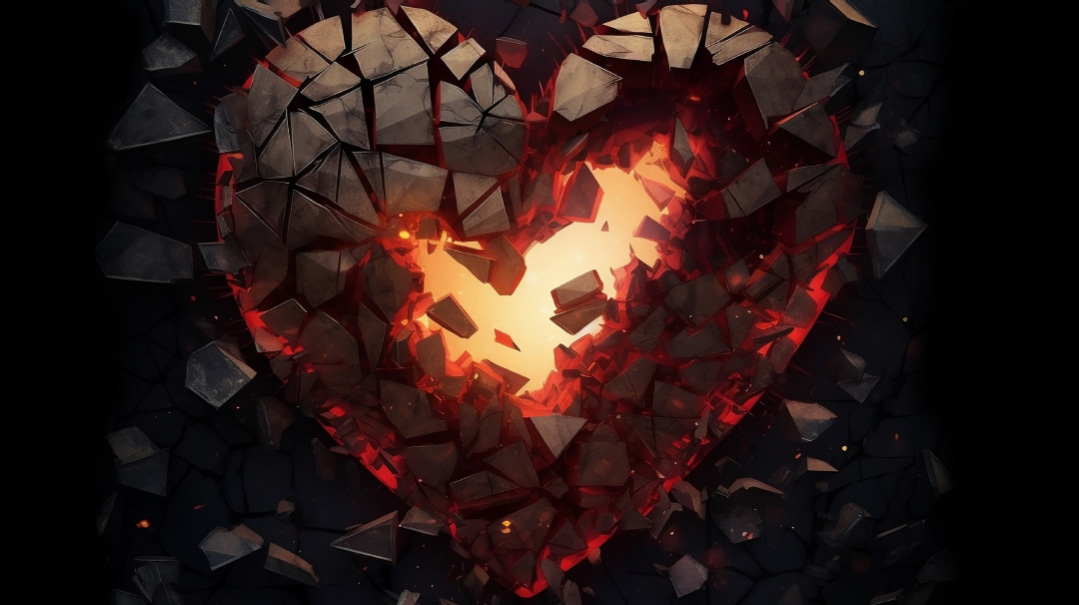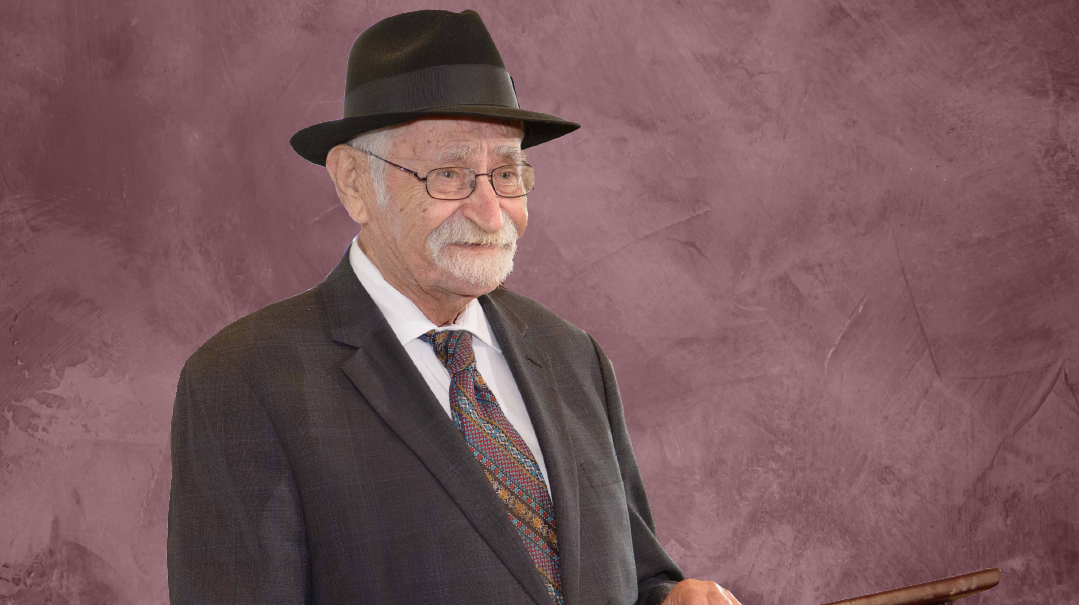Shattered Illusions

On the Zoom screen, I could see my mother start to cry. “You were being destroyed, Gershon,” she said softly. “I had to get you out of the situation. I know it hurt you, and I’m sorry.”

One Friday afternoon, I called my mother to wish her a good Shabbos.
“Hi, Gershon!” she greeted me, in her usual cheerful tone. “How’s everything?”
Suddenly, I felt a powerful, inexplicable desire to see her. Since she lived far away, visiting her before Shabbos was not an option, so I asked her if we could switch to Zoom.
I’m a grown man, 36 years old, with a family of my own. But as soon as my mother’s face came up on the screen, I burst out crying.
“Do you remember that moment that you left me?” I said. “I live with it every day of my life.”
I was nine years old when my mother told me she was taking me to a different city for a vacation. I boarded the plane with her, wondering where we would stay and what sights we would see.
As we sped from the airport in a taxi, I gripped my brand-new Mickey Mouse suitcase tightly. My mother was uncharacteristically quiet, and I felt a queasiness that was unlike any motion sickness I had ever experienced before. Why had my mother insisted on packing me so much clothing, for what was supposed to be a three-day trip?
We stepped out of the cab in front of a large, ugly townhouse covered with an angry mass of ivy.
“You’re going to be staying here,” she said softly, a tremor in her voice.
I stared at her in disbelief, then grabbed on to her arm.
A woman stepped out of the neighboring townhouse, took a look at us, and said, “Is everything okay?”
My mother pointed to the house we were standing in front of and said, “Can you call Mrs. Schwartz?”
Moments later, the neighbor and Mrs. Schwartz emerged from the house, pulled me off my mother’s sleeve, and dragged me into the house, kicking and screaming. The neighbor slipped out, and Mrs. Schwartz locked all the windows and doors, leaving me to roam the house, desperately seeking a way out. By the time they unlocked the doors, my mother was far, far away.
For the next three years I lived with this family of strangers as a paying boarder, attending an unfamiliar school, and in general feeling completely hefker.
Today, as an adult, I understand why my mother had to do what she did. My father was unstable, and I was experiencing severe bullying in school, so she feared for my safety. But at the time, I could not understand why she was doing this to me. We had always been soulmates, and she understood my sensitive nature like no one else.
When I was 12, my mother finally got divorced, and then I was able to rejoin her and my siblings. Wanting to bury the past, I threw myself into my Torah learning in yeshivah, thinking that the more intensely I learned, the happier I would be.
But I never did feel happy. There was always this gnawing pain inside me, which I was vaguely aware of but couldn’t understand or acknowledge. I didn’t know it wasn’t normal to feel this way, so I just kept pushing myself to learn more.
When I was around 20 years old, I started to suffer from terrible headaches and a completely frozen neck, which made it difficult for me to learn or even read. I got married at 22, when I was still suffering from the headaches, and my shanah rishonah was quite a challenging time, because I was not in a good state physically and I had no understanding of what was bothering me emotionally.
Seeking relief on both those fronts, I read numerous self-help books, and came across an approach called the Sedona Method. It involves identifying your feelings and sensations and asking yourself whether they are coming from the desire for security, control, love, or oneness, the premise being that all of our feelings stem from one of those longings. Once you choose one of the options, you ask yourself, “Can you let it go?” The answer could be yes or no, but either way, you let it go.
Within three months of intensive work on my own with this method, my physical symptoms disappeared. Today I understand how the method works, but at the time I just went through the motions.
Even after I felt better physically, I still struggled with unexplained feelings of anger and deep pain. Thanks to my mother, who was consistently loving, present, and upbeat, I knew how to be a good, devoted husband and father. Occasionally, however, I would feel overcome with sudden rage, with little provocation. I couldn’t understand why my moods fluctuated so abruptly.
Recognizing that my internal reactions were overblown, I would retreat to a different room and lock myself in there for a few hours, until I managed to calm down.
At the time, I attributed my inner pain and frustration to my inability to learn Torah. Maybe if I’m successful in business, I’ll feel better, I thought.
I opened a business with several employees and threw myself into managing it. The business was successful and supplied us with a decent income, but it still didn’t fill the void inside me. Some days, in middle of work, I’d dash out to the car and burst into tears, for no apparent reason. Am I crazy? I would wonder. Which grown man flees to the car midday to cry for no reason?
Seeking to quell my feelings of emptiness and inadequacy, I opened another company, which required a massive financial investment. The company was successful initially, but provided none of the internal relief I was seeking.
I assumed that this was due to the stress of running the business on my own, so I reassured myself that when I was able to hire more workers and generate a steady stream of revenue, I’d find inner peace. But the business blew up in my face, eventually becoming too difficult for me to maintain. That, too, was not the Promised Land. It was then that I realized I was sabotaging my life, and what I needed was not money and success, but a healthier mindset. I let go of the first business and redoubled my pursuit of the tranquility that seemed so elusive.
Over the years, I signed up for various self-development courses online, and tried different therapies. All these helped me along my journey, but I was plagued by the consistent, nagging sense that something was missing. No matter how much inner work I did, I felt an existential emptiness and a deep yearning for connection.
Looking back, I recognize that I was the perfect candidate for addiction, since the profound, unexplained pain and emptiness I was experiencing put me at high risk for addictive or escapist behaviors. (If you’ve never experienced this kind of deep suffering, you won’t know what I’m talking about.) I feel very fortunate that I never did seek out artificially induced highs or numbing lows.
Several years ago, I signed up for a personal development program based on chassidus, mussar, and mystical Torah teachings that provides a psychospiritual approach to achieving inner harmony. When I shared a bit about my own life journey with the facilitator, he challenged me by asking, “What is this yearning for something you don’t have? If you want something, why don’t you just go out and get it?”
I couldn’t answer his simple question, so he gently guided me to focus on what was going on inside me. I felt like I was in free fall, and could not bear to face the abyss I sensed before me. But he kept redirecting my attention to those scary feelings, holding me in them as I fought to avoid them.
“That free fall will end,” he assured me, “if you just stay with it.”
That experience broke down a barrier in my heart, and I realized for the first time that the mountain of rage I was sitting on was really a defense mechanism blocking me from the terrifying emotions underneath, which my consciousness would not allow me to see or feel. Below that mountain were buried feelings of overwhelming hurt and betrayal, which, as a young child, I had been unable to process.
“The rage can be your engine,” the facilitator informed me. “It’s the power you have inside you to build your life the way you want. You need to reclaim that power. When you can face the void without falling into it and see it as something separate from you, you will realize that the emptiness is just an illusion.”
That session smashed me to pieces. I now understood that everything I had thought about myself was wrong. My whole life, I had been unconsciously running away from the pain of my father’s instability, my friends’ bullying, and my perception of my mother’s abandonment, never even realizing that these were the primary motivators in my behavior. Despite all the learning I had done, all the therapy I had been to, all the self-help books I had read, and all the online courses I had taken, neither I nor anyone else had identified that I was suffering from complex trauma.
I now understood just how complicated that trauma was. My mother, who had been my source of love and safety, had also been the source of the biggest hurt in my life, because it was she who dropped me on the doorstep of a strange family in a new city, leaving me stunned and abandoned. Deep down, I was harboring a conflict I couldn’t live with: the love and safety I had received from my mother on one hand, and the profound lack of safety she had triggered on the other.
It was at this point that I decided, on the spur of the moment, to share my anguish with my mother that Friday afternoon.
“Do you remember that moment that you left me?” I said in a half-whisper. “I live with that feeling of abandonment every moment of my life. My whole perception of the world is from a place of crippling fear and lack of safety.”
On the Zoom screen, I could see my mother start to cry. “You were being destroyed, Gershon,” she said softly. “I had to get you out of the situation. I know it hurt you, and I’m sorry.”
We cried together for a few minutes, and then she asked me for forgiveness.
“I have money in a savings account that I’m not going to need anymore,” she told me, just before we wished each other good Shabbos. “Take all of it, and use it to do whatever you need to do to help yourself.”
Two weeks later, she was killed in a freak accident.
My mother was a good mother by every definition, having made the best of an impossible parenting situation. She tried valiantly for years to keep her marriage together, and eventually she took the brave step of leaving that untenable relationship and raising her children alone, doing a remarkable job of instilling me and my siblings with good values and middos. Still, she made mistakes, although I’m hesitant to call them mistakes; she did the best she could despite very difficult circumstances.
Overcome as I was with grief after her passing, I was nevertheless profoundly grateful for the opportunity to have shared with her how her leaving me had affected me for life. I did not have to carry that secret within me as I mourned her, and I had the comfort of knowing that she had deeply felt and validated my pain without falling apart or losing her self-respect.
Now it was time to honor her memory by coming to peace with the pain she was part of and using it as a catalyst for the growth I was meant to do in this world.
I dove deep into a new path of healing, which took a giant leap forward when I came across a book called The Body Keeps the Score. This book explains how, when people go through an overwhelming situation — what we call trauma — their brain can’t process the experience in a linear way. Instead, the memories are stored in fragmented sensations and feelings, and the person gets stuck in a fight-or-flight state, since the body never reached a place of safety that would allow it to discharge that energy.
Because traumatic memories are incoherent, the book postulates, for the PTSD sufferer, conventional talk therapy and purely cognitive healing approaches are typically futile, even counterproductive. The body can’t tell the difference between talking about the traumatic event and actually going through it, so talking about it can actually re-traumatize the person. The only way to heal the trauma is through a somatic approach that speaks directly to the body and largely bypasses the conscious mind. You need to really feel the emotions you experienced during the event, place them in a context that you can grasp, and then give closure to what is essentially a biological repair process.
This new insight spurred me to seek healing through the modality of EFT (Emotional Freedom Technique), which combines somatic (body) healing with cognitive therapy and exposure therapy. This deceptively simple technique proved, for me, to be the final piece of the puzzle. All the work I had done over the years to understand myself and build positive core beliefs came together when my body learned, through EFT, that the traumatic events of the past are over.
Unlike other forms of therapy I pursued, which dragged on for years, the healing of EFT happened rapidly, in just a few months. Another difference between EFT and traditional therapy is that in EFT, the role of the therapist is not to create a healing relationship, but simply to act as a technician in guiding me to safely peel away the layers of trauma inside. I was the one doing the work — the therapist was there only to help me implement the technique effectively and ensure that I did not drown in the powerful emotions that kept surfacing.
While EFT is not complicated, it’s difficult to do it on your own, because when the feeling of overwhelming pain hits you, it crashes your consciousness, leaving you with no way to separate between yourself and your emotions.
Through the tapping on various acupressure points and statements of self-acceptance that are the main components of EFT, I was able to release the trapped “body memories” of my childhood trauma and reclaim the parts of myself that had been frozen in a state of PTSD. I had to go back to the angry little boy inside me and keep on reassuring him, “It’s okay to be angry. It’s okay to feel hurt.” That child is still angry and hurt, but he knows that whenever he wants to express himself, the adult me will honor him and listen, instead of trying to shut him down.
The little Gershon, I discovered, felt perpetually misunderstood and threatened. Because his perception was that the world was a dangerous place, where people were out to get him, he was never able to step gracefully into the role of a secure, confident adult who could trust and be vulnerable. Now, with the help of a skilled EFT therapist, the adult Gershon was able to hold the hand of that inner child and give him the context and safety to process and resolve the traumatic events of the past.
The way I understand it, the inner child is really just a metaphor for the heart. The heart is not rational, but that doesn’t mean it’s irrational; it has its own way of interpreting and experiencing events. It doesn’t understand the logic we try to impose on it, so we need to speak its language. When the heart is flooded with emotion, it’s like an overwhelmed three-year-old child. There’s no use reasoning with a wailing, frightened toddler or trying to convince him that there’s nothing to be scared of. All you can do is hold him and calm him down by virtue of your steady, nonjudgmental presence.
It doesn’t help, by the way, to tell yourself or another person to have emunah when they’re experiencing anguish or fear. That just adds another layer of guilt and resistance. First, you give space for the feelings to exist, and then you can gently guide the heart to trust and experience true emunah.
Contemporary research shows that the lifetime of an emotion is 90 seconds. By sitting with a painful feeling for just a minute and a half and not engaging your consciousness with the emotion, you release it. Those 90 seconds can be excruciating, though, and that’s why so many people are terrified to face their feelings, and would do anything to escape their inner pain.
Recently, I started working to help others along their healing journeys, using a combination of modalities I’ve learned over the years, including EFT. This psychospiritual approach connects people to a deeper, expansive field of consciousness — which we know as the neshamah — and helps them draw upon their own innate wisdom. In my work with clients, I am continually amazed by the ingenious defense mechanisms our consciousness creates to keep the fragile and hurting parts of ourselves hidden and inaccessible.
A certain client came to me because he wanted to stop the self-destructive patterns of behavior he was engaging in and felt powerless to end.
“What would happen if you would let yourself feel, but really feel, the pain that’s lying under all this?” I challenged him.
“I would collapse,” he replied immediately.
We tapped on that, which brought him to recognize that behind his self-destructive behavior lurks the trauma of his parents’ divorce so many years ago. A memory surfaced of when he was four years old and his father walked out of the house with a suitcase, while everyone was crying.
From the point of view of his consciousness, his destructive behaviors are actually constructive, because they shield him from the immense pain inside him that he has not yet been able to safely confront or give context to. Just the knowledge that his problematic behaviors developed out of a primal need for self-protection allowed him to feel compassion for himself, which lessened his urge to engage in those problematic behaviors.
Through the tapping, he experienced enough safety in his body to face his childhood loss and feel it fully. He was then able to acknowledge that the darkness and pain are just a memory — a collection of dubious beliefs programmed into his psyche, which he has the power to replace with a new set of healthy beliefs.
When clients enter my office and start relating their life stories, I gently shift them, through EFT, to feel the story the body is telling — which is usually a completely different story. Because our perception of reality is filtered through the subconscious prism of our life experiences, if we heal our inner world, we can begin to experience a completely different paradigm of reality.
Some clients come to me reluctantly, and are wary of the process. I’ve even had clients who have told me, “I feel like an idiot sitting here, and I don’t trust you.”
“So let’s tap on that,” I tell them. “Repeat after me: ‘Even though I feel like an idiot and I don’t trust you, I still accept myself the way I am.’”
Then we do the tapping. Invariably, the reasons for the person’s inability to trust quickly rise to the surface — and then we tap on those as well, until we uncover the core of the hurt.
Clients often tell me that they believe that everything is from Hashem, and whatever happened to them is for the good. “That’s what your mind knows,” I reply. “But let’s tune in to the heart. What does your heart say?”
Once they have this permission to feel, they’ll say something like, “My heart feels abandoned and alone.”
One client told me that we’re not allowed to express what the heart feels, because that’s kefirah.
“Maybe,” I replied, “but ignoring your emotions won’t make your heart believe. The first step of teshuvah is admitting and acknowledging your true feelings. You spend a lifetime dictating to yourself what to feel. Let’s explore a different way of interacting with your heart.”
So we sit with the pain, stare it down, and peel away the layers of trauma and hurt, until we reach the place of safety and wholeness at the other end of the tunnel. There we discover that we are bigger than the pain, and that the light of our neshamah shines more brightly than any negative experiences, emotions, or behaviors.
That’s the ultimate escape: an escape from the illusions that hold us captive to our fears, hurts, and resentments. And once those illusions are shattered, we can begin to truly live.
(Originally featured in Mishpacha, Issue 961)
Oops! We could not locate your form.







